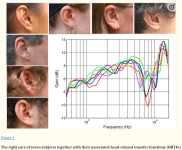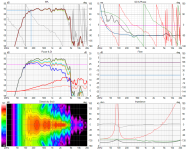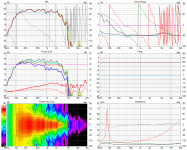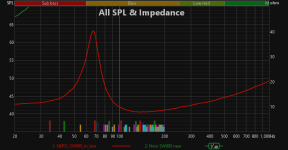I found below some time ago:
"Rainer Weber studied a body of research by Professor Jens Blauert, of the University of Bochum, Germany, who wrote Spatial Hearing: The Psychophysics of Human Sound Localization. His research led Weber to design into the Kawero! Classic some very slight frequency-response shaping to accomplish some specific sonic goals. A slight peak between 5 and 8kHz is said to raise the virtual height of singers to about 1.6m, or 62”. Another slight peak, between 1 and 2kHz, purportedly deepens the soundstage."
"Rainer Weber studied a body of research by Professor Jens Blauert, of the University of Bochum, Germany, who wrote Spatial Hearing: The Psychophysics of Human Sound Localization. His research led Weber to design into the Kawero! Classic some very slight frequency-response shaping to accomplish some specific sonic goals. A slight peak between 5 and 8kHz is said to raise the virtual height of singers to about 1.6m, or 62”. Another slight peak, between 1 and 2kHz, purportedly deepens the soundstage."
Yes, if sounds appear to be lokalised higher than speakers usually points to an issue with filter between mid and high .
The importance of the 1-2kHz cannot be overlooked. It is the range where our hearing has its highest sensitivity for spl and for direction and distance.
And for (larger) distance the recorded reflections are important as it adds cues for perceiving distance.
The importance of the 1-2kHz cannot be overlooked. It is the range where our hearing has its highest sensitivity for spl and for direction and distance.
And for (larger) distance the recorded reflections are important as it adds cues for perceiving distance.
Those charts are about tone range and tonality. Not so about the soundstage width and depth.
The Jens Blauert study is about sound location.
I have only the original german version, there is an english translation probably.
What i know is that low frequencies play a significant role in depth(and width) of soundstage (basically the room modes and boundary reflections of the room where the recording is made). Cannot find the papers that describe this.
The Jens Blauert study is about sound location.
I have only the original german version, there is an english translation probably.
What i know is that low frequencies play a significant role in depth(and width) of soundstage (basically the room modes and boundary reflections of the room where the recording is made). Cannot find the papers that describe this.
Attachments
I am not saying it is not important but 500hz-5khz is where I understand the mind keeps time? The head shadow is part of 1-2khz. JBL tends to put XO's here. (I use a head shadow image as my avatar). Forward perception will be very different here person to person.The importance of the 1-2kHz cannot be overlooked.
The inner ear is what boosts 3-4khz.
https://www.ncbi.nlm.nih.gov/pmc/articles/PMC4123622/

Just the ear shape shows a 8db difference between people.
https://www.researchgate.net/publication/352265058_Audibility_of_Group-Delay_Equalization
David Griesinger is a resercher who has a good website about psychoacoustics, including localization in halls and with stereo loudspeakers in small rooms
http://www.davidgriesinger.com/
http://www.davidgriesinger.com/
Cool link. It really shows why even papers that use headphones can ignore what the ear and head shape do to sound person to person.David Griesinger is a resercher who has a good website about psychoacoustics, including localization in halls and with stereo loudspeakers in small rooms
http://www.davidgriesinger.com/
Indeed! Guess I should have noted reacting to The importance of the 1-2kHz cannot be overlooked.Those charts are about tone range and tonality. Not so about the soundstage width and depth.
@danibosn Can you provide some details about the magnitude of these "slight peaks"? I am curious to find out. I also wonder if any components of this research made it into Apple's Spatial Audio product."...A slight peak between 5 and 8kHz is said to raise the virtual height of singers to about 1.6m, or 62”. Another slight peak, between 1 and 2kHz, purportedly deepens the soundstage."
There is one presentation of David about the effect of phase changes on intelligible of words, .David Griesinger is a resercher who has a good website about psychoacoustics, including localization in halls and with stereo loudspeakers in small rooms
http://www.davidgriesinger.com/
Looking for it in my digital dungeon.
I share your sentiment. I suspect many of us on this site do. Speaking for myself, I greatly enjoy the speaker design and construction process because of the creative blend of engineering, science, and art (aesthetic design).Finally, I should probably say this.. after the last 3 years of this speaker building and endless crossover/system tweaking journey, I have realized that I am not the kind of music-first audiophile who enjoys just music on that one system for tens of years.. 😀
I need to take up engineering challenges w.r.t designing speakers.. That part keeps me more 'alive' than listening to music alone.. Off course, I really enjoy listening to music as well but the other part is just so much more exciting.. 😀
Can only concur, i love to listen to music, but i am also an (mechanical/shipbuilding) engineer, and enjoy designing creating and learning new aspects.
So in the morning while sun is coming, with a double espresso listening to a piece of music is very special to me.
So in the morning while sun is coming, with a double espresso listening to a piece of music is very special to me.
Boxes are getting ready for the first system configuration.
I put together a box for the 15PR400 and installed a driver in it (box has 50mm thick damping material inside at the back of the driver).
I also took some measurements of the Rosso65CDN-T and the 15PR400 in box

Measurements of 15PR400 in box

Measurements of SB audience Rosso65CDN-T on EXAR 400

Prototype crossover and responses

Crossover around 850Hz




Next task is to make that big and heavy subwoofer box ready and integrate it to this system 🙂
I put together a box for the 15PR400 and installed a driver in it (box has 50mm thick damping material inside at the back of the driver).
I also took some measurements of the Rosso65CDN-T and the 15PR400 in box
Measurements of 15PR400 in box
Measurements of SB audience Rosso65CDN-T on EXAR 400
Prototype crossover and responses
Crossover around 850Hz
Next task is to make that big and heavy subwoofer box ready and integrate it to this system 🙂
Attachments
Looks very nice.
Did you do any research into how to position the horn relative to the woofer? I'm (slowly) working in something similar and was wondering this.
Should you try to place the horn as close as possible to the centre of the woofer in this case?
Did you do any research into how to position the horn relative to the woofer? I'm (slowly) working in something similar and was wondering this.
Should you try to place the horn as close as possible to the centre of the woofer in this case?
@CoolJazz: I haven't done any study yet about the horn placement on top of the cabinet. I just put the horn on top of the woofer cabinet and the C-C distance was about 35cm in above set up. The estimated crossover was around 900Hz. So I thought it (c-c spacing) will be close to 1x wavelength at crossover. This 1 to 1.4x wavelength at crossover can turn out to be a good compromise (with certain crossover topologies) and as long as I am not able to bring the c-c less than 0.3-0.5x wavelength at crossover..
However, in this case, my crossover design iteration has just started and i have to explore and check if better responses can be obtained
However, in this case, my crossover design iteration has just started and i have to explore and check if better responses can be obtained
I guess that the wide-mouth horn's "acoustic center" is vaque and practically impossible to simulate with the woofer. Both verticall and depth dimension.... 900Hz is rather forgiving xo too, eexperiments with measurements will tell more. I was surprised to see such good vertical dispersion in post #2033.
Measurements of the subwoofer system 🙂
This was hard.. really really hard.. The subwoofer in box is about 40kgs in weight.. So moving it around is a nightmare.. 😲
But I did that somehow..
Subwoofer system assembly
The innards

Inside the box is again that 50mm thick damping material behind the driver. I didn't use much since at the frequencies of concern, this material does next to nothing.. The hope was that there will be some effect like increase in apparent volume
I used this material inside: https://www.auralexchange.com/produ...b9b3CEg4gC2uoGUX6IHsSZNDYFkwvxxxw4GdhZFbWKFXJ
Damping material effectiveness

The black thing lining the ring above is foam gasket material.. It holds the NERO SW800 driver magnet and keeps it there snugly.. 🙂
The assembled box looks like this (kept on top of the rotating stand for measurements. Dont ask me how I did that🤐)

And the measurements..


This was hard.. really really hard.. The subwoofer in box is about 40kgs in weight.. So moving it around is a nightmare.. 😲
But I did that somehow..
Subwoofer system assembly
The innards
Inside the box is again that 50mm thick damping material behind the driver. I didn't use much since at the frequencies of concern, this material does next to nothing.. The hope was that there will be some effect like increase in apparent volume
I used this material inside: https://www.auralexchange.com/produ...b9b3CEg4gC2uoGUX6IHsSZNDYFkwvxxxw4GdhZFbWKFXJ
Damping material effectiveness
The black thing lining the ring above is foam gasket material.. It holds the NERO SW800 driver magnet and keeps it there snugly.. 🙂
The assembled box looks like this (kept on top of the rotating stand for measurements. Dont ask me how I did that🤐)
And the measurements..
Attachments
Moving to the exciting part
Now the system looks like this ("for now") 😀


Yes.. I know.. I have to get a proper stand done for the horn.. 😀
But this was how it was measured.. 🙂
The backside facing the wall..

Now the system looks like this ("for now") 😀
Yes.. I know.. I have to get a proper stand done for the horn.. 😀
But this was how it was measured.. 🙂
The backside facing the wall..
Now to awaken the beast.. 😎😎
System integration and crossover (ignore the gain settings on each driver branch for now..)



CD-horn has a 15uF capacitor in series with it (all measurements of the horn include this also)

Crossover points (108Hz & 820 Hz)


All these for now.. more work needs to be done including potential FIR filter based phase linearization above 200Hz or so and inroom response based subwoofer EQ.. 🙂
But the highlight is this (for now):

System integration and crossover (ignore the gain settings on each driver branch for now..)
CD-horn has a 15uF capacitor in series with it (all measurements of the horn include this also)
Crossover points (108Hz & 820 Hz)
All these for now.. more work needs to be done including potential FIR filter based phase linearization above 200Hz or so and inroom response based subwoofer EQ.. 🙂
But the highlight is this (for now):
- Home
- Loudspeakers
- Multi-Way
- A 3 way design study


